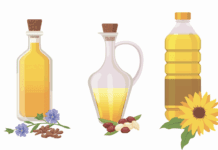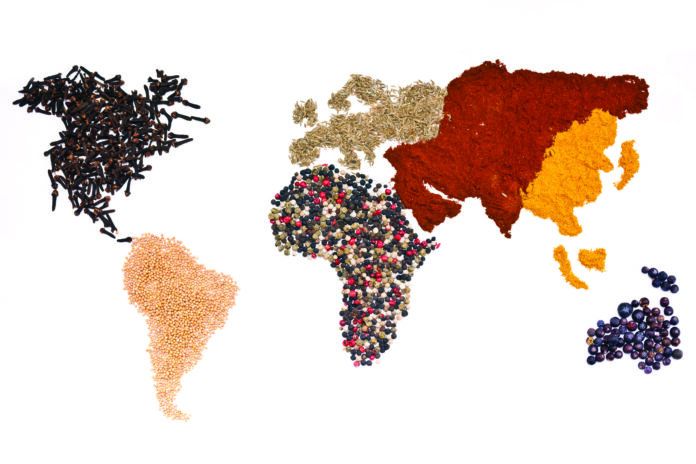Research is clear that consuming whole and minimally processed plant foods in place of refined carbohydrates, highly processed foods, and some of the usual animal proteins in your diet is good for overall health. For example, studies have shown that following a Mediterranean-style dietary pattern is associated with lower risk of heart disease, type 2 diabetes, and cognitive decline. “Eating patterns vary among the countries surrounding the Mediterranean Sea,” says Sharon Palmer, MSFS, RDN, ‘The Plant-Powered Dietitian,’ “but they share key elements, like the use of whole grains, beans, lentils, vegetables and fruits, olives and olive oil, moderate wine, and low use of processed foods, with fish and seafood as the main animal protein.”
➧ Lead With Plants. Follow the global tradition of making plants the base of your next dish or meal.
➧ Be Daring. Step outside your food comfort zone and try a new dish from a favorite region, or find recipes that utilize an unfamiliar ingredient from the local market, farmers market, or ethnic market.
➧ Add Spice. Herbs and spices often create the unique flavor in international dishes. Purchase single ingredient herbs and spices or look for blends (like Chinese five spice powder or Indian garam masala).
Plant foods are also the backbone of other delicious cuisines around the world. Popular American foods, on the other hand, are often based around red and processed meats with refined carbohydrates and starchy vegetables (think a hamburger or hot dog on a bun with fries or chips). Exploring global food traditions is a great way to get inspiration and ideas for swapping in your own plant-based meals. Let’s get started with a few examples!
Latin America. Each of the 33 countries included in this region have their own ways of making use of locally available plants like squash, sweet peppers, chiles, plantain, tomatoes, onions, garlic, cilantro, and oregano.
“Many traditional dietary patterns in Central and South America, Mexico, and the Caribbean islands are based on the combination of beans and maize (corn) or rice,” says Palmer. Traditional Mexican foods, for example, include frijoles (refried beans) with whole-corn tortillas and red beans and rice, served with veggie-based sides like salsa and guacamole.
This recipe for “Wild Rice Salad” combines nutty, chewy, wild rice (a fiber-rich grass seed native to North America) with corn, squash, and beans (all native to South and Central America) and the tangy, smoky, salty flavors of lime, chili powder, and Mexican queso fresco cheese. A serving of this salad not only has as much protein as a typical hamburger, but also provides 13 grams of fiber towards your daily 20-to-30-gram goal, plenty of vitamins, minerals, healthy fatty acids, and phytochemicals, and none of the saturated fat and refined flour you’ll get from the burger and bun.
“A green leafy vegetable often plays a central role,” says Palmer, “along with tomatoes, peppers, squash, and spices, and a large variety of fruits like bananas, mangos, papayas, and pineapple.” Grains, including millet, teff, sorghum, rice, maize, and wheat, are integral to the diet, typically prepared as a side dish, bread, or porridge. Many ingredients are available in American markets, and some are common pantry staples, like the peanut butter used to make this hearty, warming African peanut soup rich in healthy unsaturated fats with a nice dose of fiber and protein.
Asia. Each of the many countries in this region (such as Thailand, Japan, China, and India) has its own distinct flavors and cooking styles—but high consumption of plant foods is a unifying component. According to Palmer, traditional diets in this region include many pickled vegetables, foods from the gourd family (squash, cucumbers, melons), leafy greens (bok choy, mustard greens, Napa cabbage), herbs (ginger, garlic, lemongrass, basil), and sea vegetables (seaweeds such as kombu, wakame, nori). Grains, including rice and noodles, and pulses, such as mung beans and soybeans, are also extremely important in the diet, she says. “Plant foods are often the base of a dish, perhaps with small amounts of animal foods included,” says Palmer, like the Indian lentil dish called dahl or a Thai curry with eggplant, basil, and tofu. The traditional Indian chickpea dish in this recipe is high in potassium (and flavor!) and low in sodium—a great combination for supporting healthy blood pressure levels. [Editor’s note: garam masala is a traditional Indian spice mix. It is available in many supermarkets. To use up the bottle, look for other Indian recipes to try.]




















